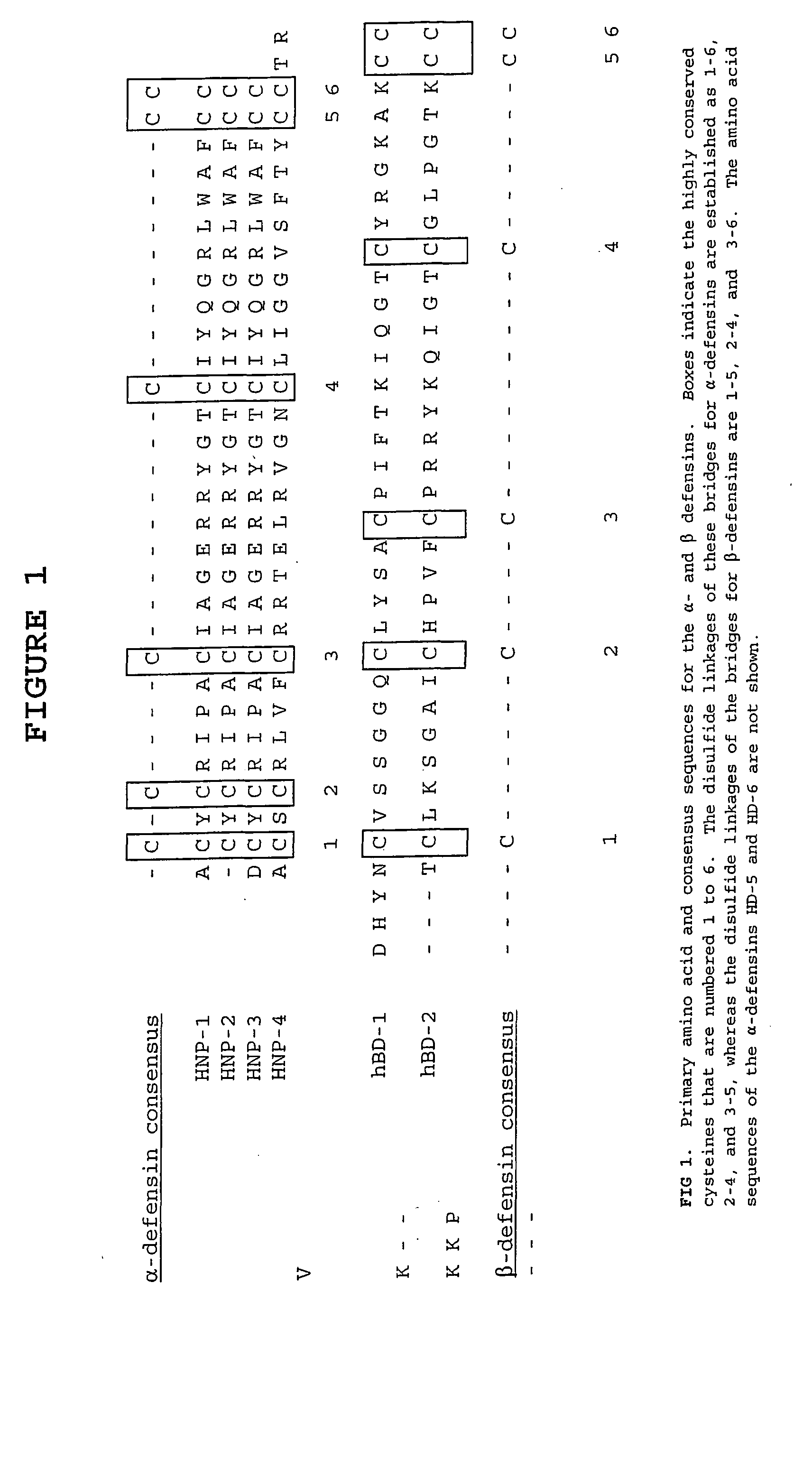Defensin-antigen fusion proteins
a technology of fusion proteins and defensin, which is applied in the field of vaccines, can solve the problems of poor immunogenicity of antigens, failure to elicit adequate tumor immunity in vivo, and single greatest obstacle, and achieves poor immunogenicity of relevant cancer antigens
- Summary
- Abstract
- Description
- Claims
- Application Information
AI Technical Summary
Benefits of technology
Problems solved by technology
Method used
Image
Examples
example 1
[0105] Materials and Methods
[0106] Mice and tumor. C3H / HeN female mice 6 to 12 weeks of age are obtained from the Animal Production Area of the National Cancer Institute-Frederick Cancer Research and Development Center (NCI-FCRDC, Frederick, Md.). The cell line 38c13 is a carcinogen-induced murine B cell tumor cell line (125). The 38c13 tumor cell secretes and expresses IgM(κ) on the cell surface and is MHC class I positive but class II negative. 38c13 cells from a common frozen stock are passaged in vitro 3 days before use in RPMI 1640 supplemented with 100 U / ml of penicillin and streptomycin, 2×10−5M 2-mercaptoethanol and heat inactivated 10% fetal bovine serum (BioWhitaker).
[0107] Construction of expression vectors. Two types of expression systems are used to produce scFv and scFv fusions. In one system, nucleic acid encoding the fusion protein is expressed in a modified pet11d vector (Stratagene) and purified from inclusion bodies of E. coli. In the second system, the nucleic ...
example 2
[0121] Six- to nine-week old female C3H / HeN mice are immunized intraperitoneally (i.p.) with 100 to 200 μg of the soluble protein in PBS and control immunogen Id38-KLH two times at two week intervals or are shaved and immunized by Accell gene delivery device (Agracetus, Inc., Middleton, WN) with 1μ gold particles carrying 1-3 μg plasmid DNA. Sera are collected by orbital bleeding two weeks after each vaccination. Serum anti-idiotypic (anti-Id) antibody levels are tested as described (111) over microtiter plates coated with 10 μg / ml native IgM 38c13. Two weeks after the last immunization, mice are inoculated with 2000 38c13 tumor cells i.p. Survival is determined, and significance with the respect to time to death, is assessed using BMDP IL software (BMDP statistical software, Los Angeles). Mice are observed daily for any signs of toxicity and date of death and animals surviving>80 days after tumor challenge are killed and reported as long-term survivors.
[0122] Mice are immunized ei...
example 3
[0141] Using various chemokines and defensins, this example demonstrates that protective antitumor immunity can be obtained by targeting immature, but not mature DC. Thus, MIP-3α and β-defensins render otherwise non-immunogenic tumor antigens immunogenic and induce protective and therapeutic antitumor immunity. In contrast, immunizations with homeostatic chemokines SLC or SDF1β do not elicit antitumor immunity. While both humoral and cellular immune responses are useful for treatment of the more aggressive 38C13 tumor that expresses IgM primarily on its surface (Campbell, M. J., L. Esserman, N. E. Byars, A. C. Allison, and R. Levy. 1990. Idiotype vaccination against murine B cell lymphoma. Humoral and cellular requirements for the full expression of antitumor immunity. J.Immunol. 145:1029; Biragyn, A., Tani, K., Grimm, M. C., Weeks, S. D., and Kwak, L. W. 1999. Genetic fusion of chemokines to a self tumor antigen induces protective, T-cell dependent antitumor immunity. Nature Biotec...
PUM
| Property | Measurement | Unit |
|---|---|---|
| concentration | aaaaa | aaaaa |
| pH | aaaaa | aaaaa |
| pore size | aaaaa | aaaaa |
Abstract
Description
Claims
Application Information
 Login to View More
Login to View More - R&D
- Intellectual Property
- Life Sciences
- Materials
- Tech Scout
- Unparalleled Data Quality
- Higher Quality Content
- 60% Fewer Hallucinations
Browse by: Latest US Patents, China's latest patents, Technical Efficacy Thesaurus, Application Domain, Technology Topic, Popular Technical Reports.
© 2025 PatSnap. All rights reserved.Legal|Privacy policy|Modern Slavery Act Transparency Statement|Sitemap|About US| Contact US: help@patsnap.com

